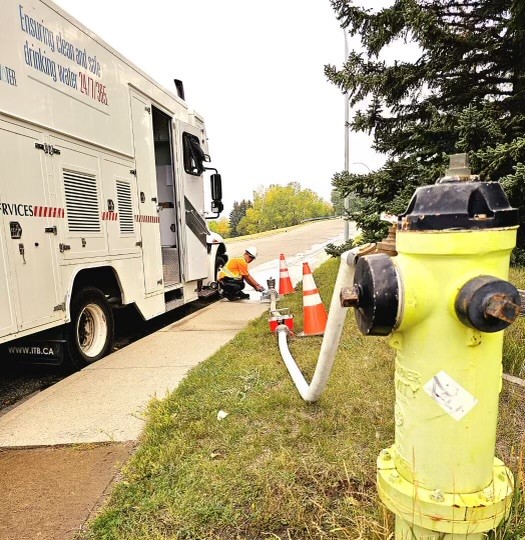Water main flushing
As part of our regular preventative maintenance of the drinking water distribution system, The City of Calgary uses unidirectional flushing (UDF) to clear water mains.
This high-speed water lifts and flushes sediment and mineral deposits from the pipes out onto the street through a fire hydrant.
UDF takes anywhere from 20 minutes to several hours per pipe, depending on the size of the pipe and the amount of sediment present.
Taking drought seriously
The City is taking steps to reduce our water use, while still meeting regulatory standards for water quality and safety and ensuring our water distribution system is well maintained. Flushing of this nature is periodically necessary to remove sediment and mineral deposits from our pipes.
In the case of UDF, we are using methods to reduce overall water volumes. For example, this type of flushing uses 40 per cent less water than traditional flushing methods.
Frequently asked questions
Why does The City drain or flush water mains using fire hydrants?
Flushing ensures we continue to provide high-quality drinking water and protects the integrity of our Water Distribution System. It’s done through fire hydrants to verify that drinking water continues to meet all related federal and provincial water quality requirements.
For example, flushing must occur after a water main is repaired to ensure any sediment and contaminants that may have entered the pipes are removed.
Will this effect water service to my home?
You likely won’t see any changes to your water. Some homes might have a small drop in water pressure or discolouration in cold water, but this will resolve once flushing is complete.
Please ensure you follow the instructions for washing and disinfecting household taps - Don't forget your bathtub tap. This information was provided to all impacted residents via the doorhanger or notice delivery.
If you do experience a water disruption, please contact 311.
Will this flood my street?
Large amounts of water will flow onto the street and down into stormwater catch basins. These are designed handle such flow and street flooding should not occur.
On some streets, inlet control devices have been installed in catch basins to slow down stormwater and these may take longer to drain.
Does the water from fire hydrants have chlorine in it? Is that harmful to the environment?
We eliminate chlorine by flushing water through a dechlorinator as it leaves the fire hydrant.
Where does the water go? What about sediment and contaminants?
The water flows into storm drains, through the stormwater system, eventually reaching the Elbow or Bow Rivers. When necessary, sediment control devices are used to prevent contaminants from entering storm drains.
Can you direct the water onto a lawn instead of down the storm drain?
Due to legal constraints about accessing private property, we cannot flush water onto a residential lawn, garden, or rain barrel.
How do you know the water is safe to drink after flushing is complete?
We use calibrated testing equipment in the field to measure chlorine and turbidity in our pipes. Additionally, we send water samples to our accredited laboratory, which are tested for basic water chemistry, inorganic substances, and microbial parameters before the water main is returned to service.
Can I park where this work is taking place?
Due to the high volume of water, there may be NO PARKING signs placed on your street during flushing. These are temporary.
Is it safe to play in this water?
No. There is a safety risk due to the volume of water. Please keep children away from all equipment, trucks and water.
Maintenance update
- Temple flushing to take place April – June 2024.
- View Customer Notice delivered to homes adjacent to flushing.


